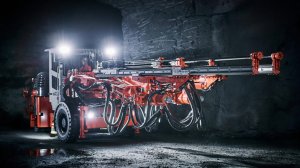The adoption of intelligent drilling technologies represents a critical step towards more efficient, safe and sustainable underground mining operations, though eco-efficient rock processing solutions provider Sandvik Mining and Rock Solutions underground drills business line manager Khomotso Duiker warns that the journey is complex, requiring a concerted effort for successful implementation.
The benefits of this move, he explains, range from enhanced operational efficiency to reduced environmental impact, and it is foundational in Sandvik’s role in the transition to advanced mining technology.
However, the broader mining industry’s willingness to embrace change will determine the pace and success of this adoption, Duiker avers.
The underground mining sector, specifically, is witnessing a significant transformation, he says, referring to Sandvik’s comprehensive suite of underground drill rigs and bolters, which are equipped with advanced technology.
“These innovations are designed to enhance drilling accuracy, operational productivity and safety, marking a shift towards more data-driven and sustainable mining practices.”
A key aspect of Sandvik’s offerings is its alignment with sustainability goals, particularly through the development of battery electric equipment models, such as the DD422iE electric jumbo development drill rig, which address the industry’s desire to reduce or otherwise eliminate carbon emissions and improve an underground mine’s costs for ventilation as a result of no longer having to offset volumous carbon emissions from internal combustion engines being used in equipment underground.
In doing so, Duiker says mines implementing battery electric vehicles contribute to a more sustainable operational framework.
Adopting new technology, the Sandvik 400-series and 300-series drill rigs now feature intelligent models that are capable of operating with automated drilling cycles through the iSure Intelligent Sandvik Underground Rock Excavation software, which Duiker says “exemplifies the company’s push towards automation”.
The Sandvik 400-series and 300-series models have been well received in regions such as Southern Africa, where diamond mining operations have reported notable improvements in safety and productivity after deploying the DD422i development drill rigs, as well as the DL422i and DL432i top hammer longhole drill rigs.
Further, a notable aspect of Sandvik's advanced machinery is the capability to upload and adhere to a mine's specified drilling blueprint for development ends, ensuring drill operations are executed with precision. This precise execution enhances blasting efficiency, reducing problems such as insufficient or excessive breaking.
The inclusion of remote control features stands out as well, Duiker highlights, adding that with the tele-remote functionality, drilling tasks can be managed from the surface, assuming the availability of robust on-site network infrastructure.
Additionally, the importance of tracking equipment performance in mining operations has grown, and Sandvik's drilling rigs are equipped with the Knowledge Box, which captures essential data such as advance speed, penetration rate and cycle times.
This information, collected through iSure, aids in refining work cycles and enhancing the drill and blast excavation strategy through detailed reports and analysis.
Duiker emphasises the importance of data connectivity, noting that many mines have already started to implement this feature.
“From a control room, operators can monitor rig performance, detecting early signs of inefficiency or potential breakdowns in real-time. This immediate access to data enables mines to enact improvements, whether in operator behaviour or equipment condition, all directed towards boosting productivity and operational time.”
The integration of intelligent machines into mining operations necessitates a strong focus on operator training and support.
Sandvik's approach in this regard includes specialised training programmes and support services aimed at ensuring operators can effectively leverage the capabilities of these advanced machines. This is coupled with the integration through assistance from product masters and Sandvik’s in-house training department.
This commitment to training underscores the importance of human expertise in increasing the benefits of automation and intelligent systems, he says.
However, the transition to intelligent drilling and automation is not without its challenges, Duiker says.
Edited by: Donna Slater
Features Deputy Editor and Chief Photographer
EMAIL THIS ARTICLE SAVE THIS ARTICLE
ARTICLE ENQUIRY
To subscribe email subscriptions@creamermedia.co.za or click here
To advertise email advertising@creamermedia.co.za or click here


















